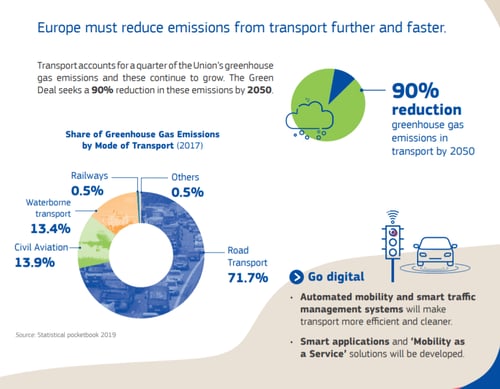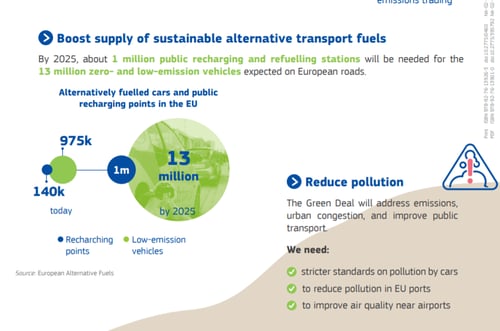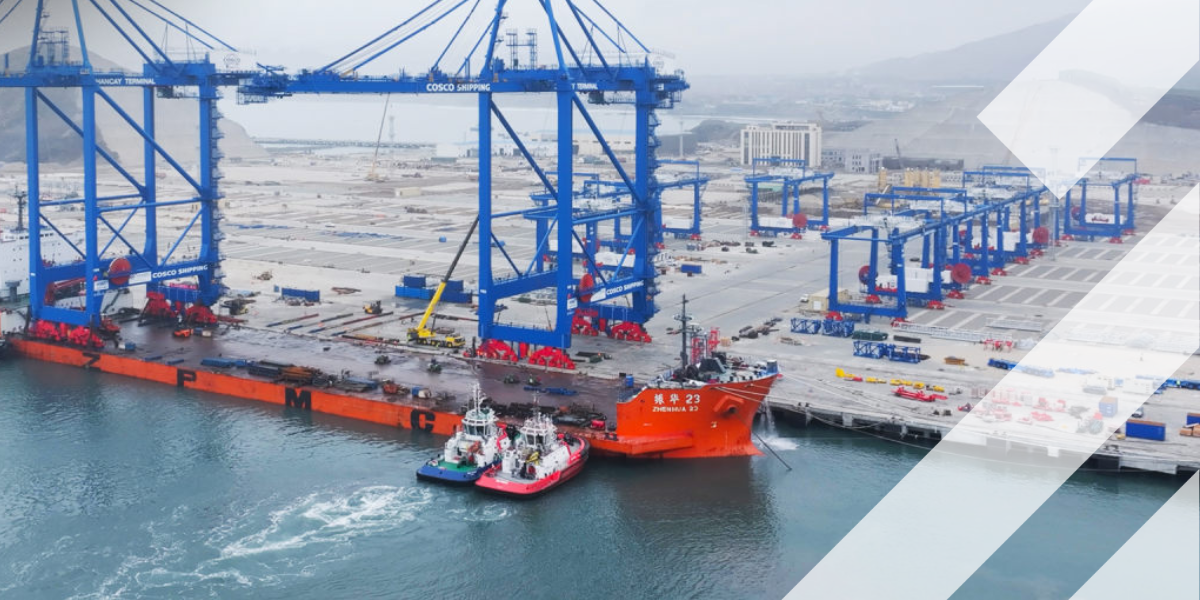Five mobility developments for a sustainable transport system towards the European Green Deal
The European Green Deal seeks a 90% reduction in emissions by 2050. Transport is one of the objectives that need to change in this sustainable mobility transition. These are the five main mobility developments that contribute to sustainable transport.
The transport and mobility sector is the second largest area of expenditure for European households. It contributes 5% to the European GDP and employs 10 million workers directly. However, transport accounts for a quarter of the Union’s greenhouse gas emissions and these continue to grow.
Transport has been one of the sectors hit very hard by the COVID-19 pandemic. The EU takes the opportunity to build a mobility system that is sustainable, smart, and resilient: a system for future generations.
Sustainable
The European Green Deal aims a 90% reduction in emissions in transport by 2050. It needs to reduce its dependence on fossil fuels, make alternative choices available and price to reflect environmental impact. By 2030, there will be at least 100 climate-neutral cities in Europe.
Smart
The EU wants to unleash full potential of data, integrate electronic ticketing facilities for seamless multimodal transport, paperless freight transport and deploy automated mobility.
Resilient
The EU aims for a strong single market, to create a mobility system that is fair for all and ensure highest standards of safety and security. Five highlighted mobility developments

1. Clean vehicles and alternative fuels
Transport accounts for a quarter of the gas emissions in the EU of which over 70% comes from transport on the road. While the overall number of trips during the pandemic decreased, the number of private-car trips increased among both public and private users compared to before the pandemic.
With the European Green Deal the Eu wants to reduce its dependence on fossil fuels. By 2030, there will be at least 30 million zero-emissions cars and 80,000 zero-emission lorries. Traffic on high-speed rail will double by 2030. By 2050 rail freight traffic will double and scheduled collective travel under 500 km should be carbon neutral by 2030.
Electric driving needs to become more attractive and facilitated. At the moment, 11 cars need to share one publicly available charging station. For electric vehicles to continue their uprising growth and success, more charging stations need to be implemented across the whole of Europe. By 2025, about 1 million public recharging and refuelling stations will be needed for the 13 million zero- and low-emission vehicles expected on European roads.

2. Multimodal transport and Mobility as a Service
COVID-19 has shown a major increase in cycling and walking in a lot of European cities. Based on an analysis of iPhone data from summer 2020, the number of passenger-kilometres travelled by private and shared micromobility vehicles has decreased by an estimated 60 to 70% in Europe and the United States. The 15-minute city seemed within our reach faster than we thought. For people to find a sustainable alternative to travel, countries and cities need to offer a seamless multimodal transportation system. This includes improving public transport and cycling facilities, offer shared mobility and regulate this in a way that an area remains liveable.
Efficiency and seamless transport is key to motivate people to choose sustainable forms of travelling. Yes, we want a liveable and healthy place to live, but we still want to travel from A to B as comfortable, fast and efficient as possible. We need to offer travellers a good mix in modes and the right applications to find an alternative as soon as one mode malfunctions. Digital technologies and data enable automated mobility and smart traffic management systems. Applications such as Mobility as a Service can improve sustainability in the cities.
Shared mobility can also contribute to offering multimodal transport. Did you know more than 40 million e-hailing trips are being booked on the two biggest e-hailing platforms every day? According to McKinsey’s 2020 ACES consumer survey, more than 60 percent of the people would share their shared-mobility ride with a stranger.
Chief marketing officer of Skedgo Sandra Witzel, offers some compelling statistical evidence that the shared mobility sector is thriving and, if anything, it’s only just getting going. “Global shared mobility passenger miles are expected to reach 18 per cent by 2035, according to Statistica and pre-Covid, the USA saw 136m shared bike and scooter trips in 2019 – 60% more than in 2018. The evidence is there. The global bike-sharing market is predicted to reach €13.8bn by 2026 and while revenues took a hit during the pandemic, McKinsey states it expects the micromobility sector to make a strong recovery.”
At Intertraffic ON AIR episode 5 experts discuss Sustainable Urban Mobility >
3. More public transport
The Green Deal will address emissions, urban congestion, and improve public transport. Can we offer a solid and attractive alternative to an airplane? By 2050, a fully operational, multimodal Trans-European Transport Network for sustainable and smart transport with high speed connectivity. Traffic on high-speed rail will double by 2030.
The Commission supports the transition to sustainable mobility through the Connecting Europe Facility (CEF). 60% of the budget on infrastructure projects have a link to sustainability and part if it is enabling a high performing interoperable European railway network.
Alex Pazuchanics, Head of Policy & Partnerships at Vianova, spoke with Intertraffic about public transit and personal transit that could, and should, be a lot more closely aligned. Shared micromobility modes offer the opportunity to provide additional modal options to the frequent need to disperse demand from central city railway hubs. “Cities have typically tried to deal with this issue through-ever increasing classic public transport capacity at these rail hubs, facilitation of taxi services, followed by increasing encouragement of walking. The integration of electric micromobility as a deliberate strategy to move people to and from central stations represents a significant opportunity for cities as they think about sustainable and resilient transport solutions,” adds Pazuchanics.
4. Charge for mobility
The negative environmental and health costs of transport, “externalities”, are not generally reflected in prices. The Commission envisages extending emissions trading to the maritime sector and reducing the EU Emissions Trading System allowances currently allocated to airlines for free.
EU action in support of the ‘polluter-pays' principle includes effective road pricing in the EU, as well as ending subsidies for fossil fuel. The internalisation of external costs of transport at the latest by 2050 needs to ensure that those who use transport will bear the full costs rather than leaving others in our society to meet them.
CEO of the Netherlands for Sensys Gatso Group, Niki Gatsonides, finds the major challenge for the future of mobility in traffic flow. He thinks we need to think of new ways of managing traffic. Something different from the ‘polluter-pays’ principle. “Instead of charging more when traveling during rush hours, I think we should receive extra credits or money when you travel outside those hours.”
5. Electric and automated vehicles
It’s a debate that has been raging for the best part of two decades – when will autonomous vehicles be a commonplace sight on our roads? In the 1990s it was thought that by 2010 automated driving would be de rigueur as auto giants such as DaimlerChrysler and Ford were investing vast sums of money into their driverless vehicle programs. Nick Reed mentions: “There was a sense at the time, 2015-2016, that we’d completed 95% of the task and that there was just this little bit to go and we'd be there - without realizing that that last 5% was as hard as the previous 95. In real terms it was 50% of the way there,” he admits.
Did you know that automated vehicles can reduce congestion, save fuels and increase road safety? Government data identifies driver behaviour or error as a factor in 94 percent of crashes. Automated driving can reduce greenhouse gases from needless idling.
By 2030, automated mobility will be deployed on large scale in the EU. Do you want to know more about where the EU stands in automated mobility? European Commissioner Tom Alkim explains more about it at Intertraffic ON AIR episode 6 on the 21st of September >
Join Intertraffic ON AIR on the 21st of September
Episode 5: The European Green Deal: Engaging in sustainable urban mobility
The upcoming European Green Deal will no doubt push forward a sustainable mobility agenda encouraging authorities, employers and service providers to offer sustainable mobility alternatives and entice commuters to use them for their daily commute. The Green Deal will force us to question the way we live. As a result many cities are currently reallocating public space to active mobility, changing parking policies and offering financial incentives to encourage micro-mobility, sustainable collective transport, pedestrianize streets and create temporary bike lanes or broaden existing bike lanes. But how do we stay on track in this sustainability transition and what is required to get things started? During this Intertraffic ON AIR episode various experts will explain what must be done to maintain the set course while ensuring mobility access for everyone. Join >
Episode 6 : Cooperative Connected and Automated Mobility: Reaping the benefits of connectivity
The pandemic brought with it the necessary challenges and adjustments for Cooperative Connected and Automated Mobility (CCAM) research and Proof of Concepts, but overall smart mobility has undergone spectacular changes with the introduction and widespread use of connected vehicle and traffic technology. The many interventions on the physical and digital road network have paved the way for a gradual move from human driving to self-driving allowing vehicles, roadways, travellers, and traffic management centres to all communicate with one another in real time. The role of the recently founded CCAM association is to speed up further European CCAM developments and aims to create a user-centred and inclusive mobility system, increasing road safety while reducing congestion and emission footprint. During this Intertraffic ON AIR episode various CCAM experts will share their ideas on reaping the CCAM benefits and deploy smart technology to connect infrastructure, vehicles and road users. Join >
Share your story
Do you have an innovation, research results or an other interesting topic you would like to share with the professionals in the infrastructure, traffic management, safety, smart mobility and parking industry? The Intertraffic website and social media channels are a great platform to showcase your stories!
Please contact our Sr Brand Marketing Manager Carola Jansen-Young.
Are you an Intertraffic exhibitor?
Make sure you add your latest press releases to your Company Profile in the Exhibitor Portal for free exposure.
Get up to speed on the mobility industry - our newsletter straight to your inbox!








